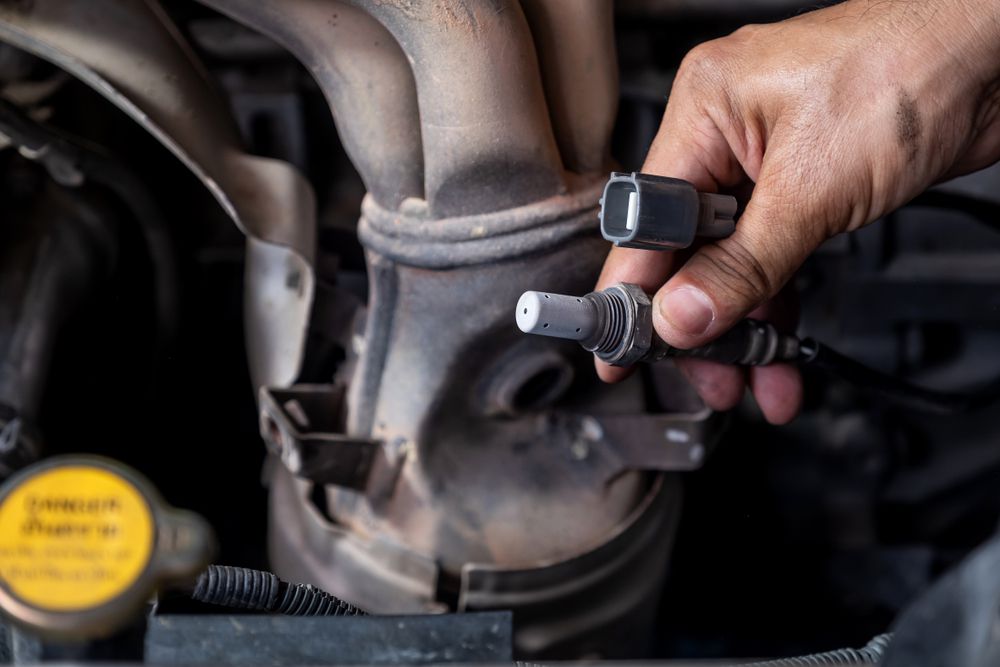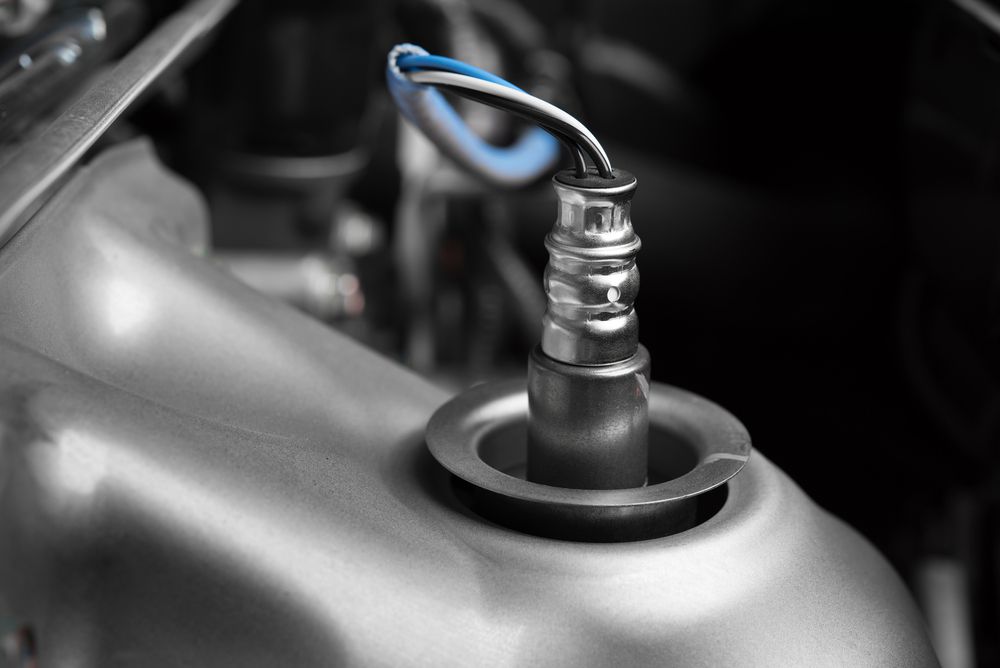Is your vehicle running better with the mass air flow sensor unplugged?
MAF (Mass Air Flow) sensors, located between the air filter housing and the intake manifold, measure the volume of air the engine entering the engine and provide the data to the vehicle's computer, making them integral to the proper functioning of the vehicle's computer.
Therefore, only cars with defective MAF sensors would run better if unplugged.
Below, we'll discuss faulty mass air flow sensors' causes, symptoms, and solutions.
 Mechanic unplugging a mass air flow (MAF) Sensor
Mechanic unplugging a mass air flow (MAF) Sensor
How Does a Mass Airflow Sensor Work and What Is Its Purpose?
MAF sensors are installed inside the intake pipe between the air filter housing and the intake manifold.
Generally speaking, they work on the hot wire principle.
In other words, mass air flow sensors have two sensing wires — one is heated by electricity, the other isn't.
The temperature drops when air flows over the heated wire, creating a difference between the sensing wires.
As soon as the MAF detects the disparity, it automatically boosts or restricts the current to the heated wire to compensate for the change.
Based on this data, this current is sent as a frequency or voltage to the engine control module (ECU). As a result, the ECU can increase or decrease the fuel entering the engine to maintain the proper air-fuel ratio.
Will My Car Run Without a Mass Airflow Sensor?
You can run a car without a mass airflow sensor, but it's highly inadvisable.
The vehicle relies on the MAF sensor signal to maintain the correct air-fuel ratio in the engine's combustion chambers.
Suppose your vehicle runs better with the MAF sensor unplugged. In that case, it indicates that your MAF sensor is faulty and needs to be replaced as the vehicle is running better with no data than the data provided by the sensor.
Unplugging the sensor will probably put the vehicle into "limp mode."
Even though the limp mode should be safe when driving, it causes your engine to "run rich," meaning it may foul the valves and result in oil and fuel mixing, so it's advisable to get the vehicle into an auto repair shop as soon as possible.
 Unplugged MAF sensor
Unplugged MAF sensor
How Do I Know If My Mass Airflow Sensor Is Working?
When your mass air flow sensor is functioning optimally, your fuel economy will be normal, it won't stall when you engage different gears, and the engine won't experience low power.
However, the symptoms of a MAF sensor problems are:
- Poor fuel economy
- Check engine light
- MAF sensor diagnostic trouble codes
- Hard or no starting
- Erratic performance
- Stalling when gear engaged
- Low engine power
- Poor or rough idle
- Engine running lean (too much air, too little fuel) or rich (too much fuel, too little air)
- Automatic transmission shifting problems
- Excessive vibrations
- RPMs change without driver input
Depending on the fault, you can do the following to test a mass air flow sensor without any equipment like a basic digital multimeter (DMM):
- Ensure the parking brake is on.
- Set the transmission to "Park" if you have an automatic or "Neutral" if you have a manual.
- Start the engine, letting it run idle.
- Open the hood.
- Tap the MAF sensor and the electrical connector gently with a screwdriver.
- Wiggle the wires.
If the engine stalls or the idle changes, you likely have a faulty MAF sensor.
In the event your engine isn't starting or is idling terribly, try the following diagnostic steps:
- Open the hood.
- Disconnect the MAF sensor's electrical connector.
- Engage the parking brake.
- Set the transmission to "Park" or "Neutral."
- Attempt to start the engine.
If the car starts or the idle improves, you need to replace the mass air flow sensor.
Some DIYers attempt to trick a mass air flow sensor into giving the engine correct readings by using a bespoke tube in front of the ignition source.
Once heated, it provides the same reading as the air-fuel mixture from the tailpipe.
However, tricking it can lead to costly damage, so it's usually best to deal with the problem head-on.
What Should MAF Sensor Read at Idle
Using a scanner to read the MAF sensor Parameter Identification Data (or PID) is the easiest way to tell whether it's faulty.
With the engine idle, the PID value should be between two and seven grams/second.
At 2,500 rpm, it should increase to between 15 and 25 grams/second, depending on your engine's size.
Always consult your vehicle's manufacturer's specifications to determine the optimal MAF sensory readings.
Does Mass Air Flow Sensor Affect Performance?
Since the MAF sensor is closely related to the engine control system, any problems can result in decreased performance.
The correct air-fuel ratio in the combustion chamber is one of the most critical parameters of an optimally functioning combustion engine.
Without a functioning MAF sensor, the vehicle's computer won't know how much fuel to add to the air-fuel mixture in the combustion chambers of the engine.
Can Mass Air Flow Sensor Affect Acceleration?
Acceleration is one of the main areas to be affected by a bad MAF sensor.
Engines require the perfect air-fuel mixture for proper acceleration, which they can't achieve without a fully operable mass air flow sensor.
Slow, rough, jerky, or hesitant acceleration are all significant signs that your MAF sensor is malfunctioning.
Can a Mass Air Flow Sensor Cause a Misfire?
Misfires are commonly caused by faulty spark plugs, spark plug wires, or ignition coils.
A bad air-fuel ratio can also cause a misfire due to vacuum leaks or a bad MAF (mass air flow) sensor.
Can MAF Sensor Cause Transmission Problems?
A bad MAF sensor won't directly cause transmission problems could cause problems like a lack of throttle response that may seem like a transmission problem.
Does Cleaning MAF Sensor Improve MPG?
Over time the MAF sensor will get covered by dust and grime, which significantly affects its ability to do accurate readings, thereby leading to a suboptimally running engine and poor fuel economy.
Luckily the MAF sensor is easy to clean, and countless tutorials are online.
To clean it, spray a generous amount of mass air flow sensor cleaner onto the sensor, ensuring you cover the whole component.
After following the instructions on the bottle, reassemble the air box, remembering to plug the harness in so the MAF can properly function.
How Do You Reset an Air-Fuel Mixture?
Sometimes, rough idling or awkwardly running necessitates an air-fuel mixture reset, and you can do this by resetting the ECU.
Follow the steps below to reset the engine control module:
- Start the car and allow it to warm up.
- Once it reaches standard operating temperature, switch it off.
- Open the hood.
- Remove the relay fuse box cover and take out these fuses:
- Hazard
- EFI
- ECU
- Leave them out for one minute.
- After 60 seconds, replace them.
- Start the car.
- Let it run for 10 minutes.
- Turn it off and start it again. You should hear your car idling better and benefit from better gas mileage.
What Does Resetting the MAF Sensor Do?
Depending on your car, the MAF sensor may need resetting after replacement to work correctly.
Luckily, the process is easy, requiring just 15 minutes.
To reset the mass air flow sensor, follow these steps:
- Make sure the engine is cool.
- Remove the connector with the sensor's harness.
- Pull out the sensor and clean or replace it.
- Turn the engine on, leaving everything as-is for five to six seconds.
- Turn it off.
- Connect the MAF sensor with its harness.
- The code DTC P0102 appears on the dashboard.
- Clean the memory, turn on the engine, and your MAF sensor is ready to go!
What Is the Difference Between Mass Air Flow Sensor and Oxygen Sensor?
The MAF sensor measures air density as it flows inside the engine, ready to be mixed with fuel.
An oxygen sensor detects the amount of unburned oxygen in the exhaust as it leaves the engine.
 Oxygen Sensor
Oxygen Sensor
Conclusion
A properly functioning mass air flow sensor is critical for a modern combustion engine to function properly.
As you drive your vehicle, a mass air flow sensor will get covered in grime, preventing it from accurately measuring the air entering the engine, which will lead to a sub-optimal air-fuel ratio in the combustion chamber.
In most cases, unplugging a MAF sensor will make your engine run worse; however, if your MAF sensor is faulty or dirty, your engine could actually run better with it unplugged.
Luckily, a MAF sensor is easy to clean or replace as need be.